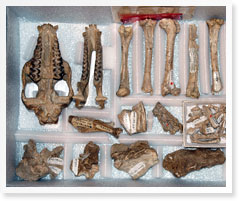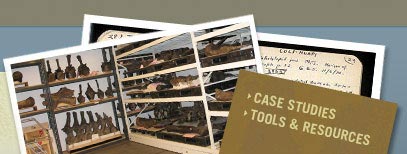Mounts and Materials
Providing proper building or room conditions and good cabinetry will go a long way towards preserving fossil specimens, but the housing of individual specimens is also an essential element and one that often requires much more customized care.
Safe versus unsafe materials for storage mounts
Generally the following materials are safe to use for long-term housing: [images: rehousing materials 2,3 and 8]
- Polyethylene
- Polypropylene
- Polystyrene
- Natural unbleached cotton
- Acid-free paper
- Mylar
- Acrylics
Materials that might off-gas or exude the following should be avoided if possible:
- Formaldehyde
- Acids
- Peroxides
- Amines
- Plasticizers
- Migrating dyes
If you are planning on buying a new storage material and want to check what chemicals have been used in its manufacture, it’s a good idea to contact the manufacturer directly. An alternative to this is to look up the material’s Material Safety Data Sheet (MSDS). Copies of these can be found on the internet fairly easily using search engines like Google – enter the product name and ‘MSDS.’ Click here to download a list of materials and vendors used by some museums for rehousing projects.
A good example of this housing, which is known as a storage mount, will not only support the specimen in storage and prevent gravity from taking its toll, but will also minimize vibration from the movement of compactor shelving or cabinet drawers, and ideally reduce handling, or at least promote safe handling.
The best materials to use for making mounts are inert, meaning non-reactive and not prone to off-gassing. There are many suppliers of these archival preservation grade materials and they can easily be bought in small quantities by individual collectors. Institutions undertaking large re-housing projects can arrange for bulk purchases (see links below for archival vendors).
Specimens in storage can suffer a number of types of mechanical damage:
- An irregular shaped object placed on a flat surface rests on only a few points of contact resulting in crushing and abrasion at these points.
- Gravity can cause specimens to break under their own weight
- Vibrations can be transmitted to specimens
- Moving cabinet drawers can cause specimens to roll or slide into each other or the drawers
- Dragging heavy specimens on shelves can cause abrasions

Whether specimens are housed in vials, trays, boxes, pallets or shelves, properly designed supports can help reduce these problems by:
- Supporting the specimen as completely as possible
- Limiting movement of the specimen in any direction
- Padding the specimen to limit shocks and vibrations
Click here to download tips on specimen rehousing from the American Museum of Natural History’s Division of Paleontology, or click here to access a presentation created by staff of the National Museum of the American Indian prepared for a rehousing workshop held at AMNH in 2006.



